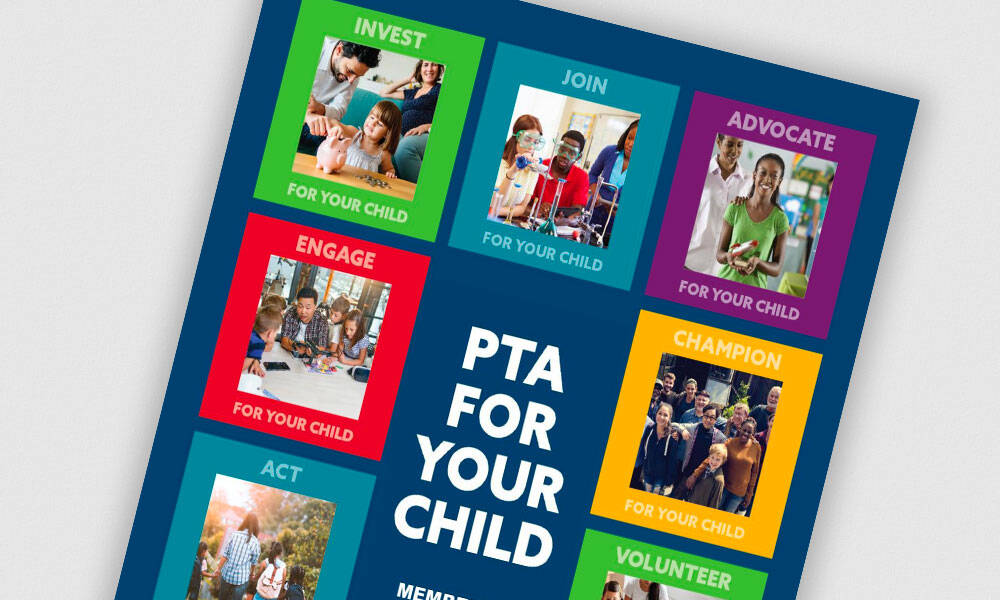
PTA Membership Campaign Clarifies Value, Purpose, and Inclusivity
Everyone has heard of the PTA, but it turns out a lot of people, including its own members, don’t know exactly what PTA does. A new campaign seeks to overcome membership barriers and sweep away preconceived notions.
Faced with declining membership and perceptions that it was a cliquish social club geared for stay-at-home moms, the National Parent Teacher Association did a deep research dive to analyze why stereotypes and misconceptions were getting in the way of membership growth. They used what they learned to create an inclusive campaign, launched earlier this year, to drive growth and clarify PTA’s mission and purpose.
PTA is the oldest and largest child advocacy association in America, with 22,000 local PTAs and nearly 3.5 million members. Over 120 years, PTA’s national advocacy has helped establish universal kindergarten, the National School Lunch Program, the juvenile justice system, and anti-child-labor laws. Its brand recognition was strong, but knowledge of what it actually does was not. That had to change.
I participated in a virtual media roundtable with National PTA President Leslie Boggs, President-Elect Anna King, Executive Director Nathan Monell, CAE, and other state and local PTA leaders to discuss the new campaign. They said they knew a new membership campaign was critical to its future success and it was especially important now, with so many children in virtual learning environments because of the pandemic.
To build a campaign grounded in fact, not assumptions, PTA started with research to identify the best ways to reach target audiences. The team conducted surveys and interviews with current and prospective members to gain insights to help successfully develop a responsive campaign.
The research uncovered some surprising findings. Top on the list? Potential members said a main barrier to joining PTA was they were never asked to join. (You read that right.) But they were often asked to support PTA fundraisers. It also found that current members appreciate all the benefits PTA provides, but they want to see the personal relevance to their own child. PTA realized that those personal connections are what is going to sustain involvement.
The research revealed a need for diversity and inclusion, too, Boggs said. Multicultural audiences are eager to be involved in their children’s education and want them to succeed. However, the research found Hispanic audiences are more likely to believe that PTA is not inclusive and is biased against low-income, non-English-speaking, and undocumented immigrants.
“Increasing multicultural participation is an opportunity for PTA and absolutely necessary for membership growth,” according to a training video introducing the campaign to local PTAs.
Communicating Value
Another key insight that helped shape the campaign was that members lack a clear understanding of PTA’s value. Current members had a difficult time explaining the organization’s role. They saw it as a social club and did not see how fundraising efforts directly affected their child.
There was also confusion about what PTA membership means. Research found that some members weren’t even sure they were members. Many saw membership as time-consuming and believed volunteering and meeting attendance were requirements.
Boggs said that all of these insights—many of them uncomfortable—led to the creative campaign to motivate and drive PTA membership and renewals. The new campaign shifts away from the negative perception that “PTA is extra” to “PTA is essential,” by showing how PTA specifically helps each child succeed.
To signify action, the campaign switched PTA from a noun to a verb—PTA for your child—and emphasizes, “There’s no wrong way to PTA.” It breaks out ways to participate: joining and donating money, volunteering, or advocating at the local, state, or national level for improving children’s education.
The campaign toolkit concisely explains all the key elements of the campaign, including its overarching message, elevator speech, proof points, and more. It aims to “make PTA’s often invisible work, visible, by highlighting the value and impact of PTA on individual children and emphasizing that membership involves as much or as little time as you have to offer.”
Right out of the gate, that gives more perspective on what PTA does—much more than organizing the stereotypical bake sale.
(National PTA)






Comments